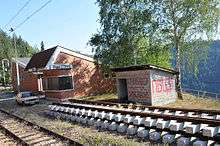Štrpci massacre
| Štrpci massacre | |
|---|---|
| Part of Bosnian War | |
 Štrpci rail station | |
| Location | Višegrad, Bosnia and Herzegovina |
| Date | 27 February 1993 |
Attack type | Mass killing |
| Deaths | 18 Bosniaks; 1 Croat |
| Perpetrators | Republika Srpska Army, Višegrad Brigade |
The Štrpci massacre was the massacre of 19 civilians (18 Bosniaks and one Croat) on 27 February 1993, taken from a Belgrade-Bar train at Štrpci station near Višegrad, on Bosnian territory. Fifteen Serbs were arrested in December 2014 and charged with war crimes for their participation in the massacre.
Background
The Belgrade-Bar railway crosses into Bosnia and Herzegovina for 9 km, between the stations at Zlatibor and Priboj, both in Serbia. There is one station, Štrpci, but there are no border crossing facilities and trains do not routinely call at the station. The abducted passengers were taken off the train, robbed and physically abused. They were then taken to the village of Visegradska banja near Višegrad in Bosnia and Herzegovina, where they were tortured and killed in a burned-out house near the river Drina. Their remains have not been found.[1]
Members of the Avengers (Osvetnici) military unit, commanded by Milan Lukić, with logistical support from the Republic of Serbia, were responsible for the abductions. Of the approximately 30 suspects the only individual convicted for his role in the crime was Nebojša Ranisavljević from Despotovac. He was arrested in October 1996. The Higher Court in Bijelo Polje sentenced him to 15 years in prison on 9 September 2002. The verdict was confirmed by the Supreme Court of Montenegro in April 2004. Ranisavljević was released from prison in 2011 after serving nine years of his sentence. The Commander of the Republika Srpska Army's (VRS) Višegrad brigade, Luka Dragićević, admitted at Ranisavljević's trial that the “Avengers” unit was part of the VRS army. After the war Dragićević was transferred to a position in the FRY Army.[1]
Amnesty International expressed concern that Ranisavljević had been made a scapegoat and that the trial was a token affair. It was alleged that Ranisavljević had been tortured in detention to force him to make incriminating statements.[2]
Senior officials in the Serbian and Federal Republic of Yugoslavia (FRY) governments were alerted to the plan to abduct citizens of the FRY but no action was taken to prevent the crime. The Štrpci massacre and the Sjeverin massacre were part of a campaign of ethnic cleansing conducted against Bosniaks in the Sandžak area of Serbia that was organised and carried out under the cover of the Bosnian war. Police and judicial officials are alleged to have obstructed court proceedings against Milan Lukić.[1][3]
See also
References
- 1 2 3 "War Crimes in Serbia - Sandzak Case". Youth Initiative for Human Rights. 27 February 2010.
- ↑ "Amnesty International's concerns in Serbia and Montenegro". Amnesty International.
- ↑ "Report on Status of National Minorities in Parliamentary Election Campaign 2007" (PDF). Youth Initiative for Human Rights. 25 February 2007.